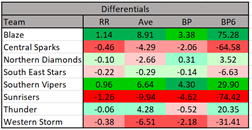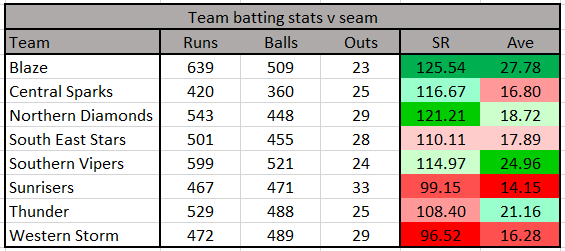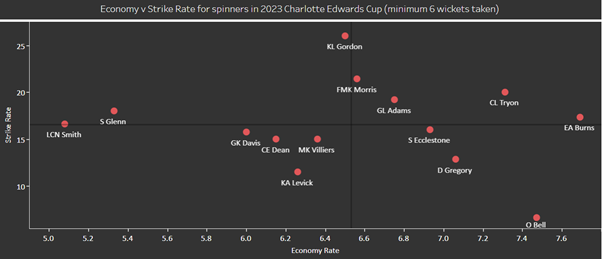By Ronan Alexander
Southern Vipers completed back-to-back Charlotte Edwards Cup triumphs after defeating The Blaze at New Road in June. The Blaze had won every pool match leading up to finals day but were undone by a Vipers side that did the domestic double in 2023. We’ll take a deep dive into an analytical review of the competition, looking at who performed best and worst in each phase, who stood out against seam and spin as well as analyzing each team’s strengths and weaknesses.


Overall Win Percentages

Two time champions Southern Vipers have been the most successful side over the three-year history of the Charlotte Edwards Cup. The only other winners South East Stars are second best, despite missing out on a play-off place this year for the first time. After only one win in two years for the previously branded Loughborough Lightning, The Blaze had by far their most successful campaign, winning every group match and topping the table before falling short in the final.
Overall Team Performances

Losing finalists, The Blaze were the leading team with bat in hand, boasting the highest run-rate, best average and strongest boundary percentage, whilst being second best in the ball per six and non-boundary strike-rate categories. In particular, it was experienced England internationals Nat Sciver-Brunt who struck at 174.77 and Tammy Beaumont (142.53 SR) who stood out for Chris Guest’s side.
Eventual winners Southern Vipers were second best across the board, whilst Northern Diamonds hit sixes the most frequently with Bess Heath clearing the ropes 6 times from the 73 balls she faced and Holly Armitage hitting 7 sixes from the 167 deliveries bowled at her. She also backed this up in The Hundred, hitting a six every 14 balls, which was the second best in that comp behind Laura Harris. Heath hit a six every 12.2 balls faced which was the best in the tournament, with Deandra Dottin of Thunder second, hitting a six every 15.1 balls.

South East Stars finished fifth in the table but had the third best boundary percentage and run rate, showing they have some nice intent with the bat. Bryony Smith was their standout, finishing as second top run scorer with 256 runs, striking at 155.15. The bottom two sides Central Sparks and Sunrisers were also the two poorest sides with bat in hand, despite Central Sparks being the best strike rotators in the competition although all 8 sides were very closely grouped in this category, and it was the boundary hitting that separated the teams rather than rotating the strike.

The top two sides again stood out with the ball, especially the Vipers who were the tightest bowling attack (economy 6.03) and most potent bowling attack, taking a wicket every 15.83 runs scored. Whilst scoring boundaries most frequently with the bat, these two sides also conceded boundaries less often than any other side, making for a perfect combination in the boundary department. Their six prevention was also excellent, with the Blaze conceding on average less than one six per innings which is an incredible T20 statistic.
Whilst Northern Diamonds were the best six hitting side with the bat, they conceded sixes more often than anyone else with the ball. Losing semi-finalists, Thunder posted above average numbers in every bowling metric, with Scottish off-spinner Olivia Bell having an outstanding breakout tournament. The 19-year-old grabbed 11 wickets in four matches at an average of 8.27, and was well supported by a nicely balanced attack where 5 of their 8 bowlers (Bell, Kate Cross, Tara Norris, Sophie Ecclestone & Emma Lamb) boasted a strike rate of 16 or less.

It’s clear to see overall why The Blaze and Southern Vipers had so much success in the tournament, whilst Northern Diamonds and Thunder performed above average in three out of the four overall metrics, whilst Western Storm will be disappointed not to record any positive overall differentials.
Team performance by phase
Powerplay

Looking at the first six overs, Southern Vipers were the standout side, especially with the ball as they conceded less than a run-a-ball. Anya Shrubsole and Linsey Smith made for an excellent opening combination. Western Storm were also very tight in the powerplay, with Lauren Filer standing out for them as she grabbed 4 wickets in the first 6 overs at an average of 20 and Irish international Orla Prendergast took three wickets in this phase at an economy rate of 5.15.
Blaze were the quickest out the blocks with the bat as Beaumont and Sarah Bryce took advantage of the early field restrictions. Meanwhile, Thunder had the best powerplay batting average with Emma Lamb and Liberty Heap building the platform for hitters including Dottin and Fi Morris to accelerate from.
South East Stars were the most volatile side in the powerplay. They were the third quickest run scorers and the third most stable side with the bat, with Bryony Smith the main player to thank for that, but the worst with ball in hand having the worst bowling powerplay economy rate and average.
Middle Overs

Northern Diamonds were the fastest scoring side between overs 7-16 as their middle order of Armitage, Sterre Kalis, Heath and Chloe Tryon impressed. They managed to achieve this quick run scoring whilst not losing wickets regularly too, as they had the second best batting average in this phase. Western Storm were the most stable side in the middle overs, but the second slowest run scorers, so will perhaps look to trade off a bit of that stability for more intent going forward. Blaze managed to keep going from the powerplay and were the only other side to score above 7 runs-per-over during the middle phase.
With the ball, Thunder were the most potent team with the ball. Having Ecclestone in their ranks helps this, but she was well supported by the previously mentioned Olivia Bell. Whilst Western Storm were stable with the bat in the middle overs, they struggled with the ball, taking wickets less regularly than anyone else and having the second worst economy rate.
Death Overs

Again, Blaze and Vipers were the two standouts with the bat at the death, although no team managed to score above 8 runs per over during this phase. Northern Diamonds lost wickets the most frequently as they struggled to capitalize on the strong positions their middle order got them into. Western Storm and South East Stars posted above average numbers in each batting category at the death.
With the ball, Vipers and Thunder were the two best sides at the death. Naomi Dattani and Tara Norris were the main go-to death operators for Thunder and took wickets regularly. Central Sparks were also strong here, going at only 6.15 runs per over, with 24-year-old Bethan Ellis performing nicely for them including taking three wickets in overs 18 and 20, going for just 11 runs in a tight 7-run victory over the Vipers.
Batting Performances versus bowling type

Blaze were the best side against seam bowling, with Vipers and Northern Diamonds also posting above average numbers in both metrics. Western Storm and Sunrisers were the biggest strugglers against non-spin bowling.

Despite their struggles against seam, Western Storm impressed against the seamers, whilst Southern Vipers and South East Stars also found joy against the spinners. Central Sparks and Sunrisers were the poorest sides against spin.
Standout Performers
Batting

Nat Sciver-Brunt was a massive standout as she made a big impact during the four matches she played, boasting the highest average and strike rate in the tournament. Danni Wyatt, Bryony Smith, Tammy Beaumont and Amy Jones also made it into that ideal top right corner. Meanwhile, Maia Bouchier, Erin Burns (dot next to Bouchier missing a label), Danielle Gibson and Emma Lamb showed great intent with above average strike rates. Georgia Adams and Sophie Luff boasted high averages but didn’t quite have the same intent.

Nat Sciver-Brunt was the most dynamic batter, whilst Danni Wyatt, Alice Capsey and Danielle Gibson all boasted excellent intent against spin bowlers, something Wyatt has done throughout her career.

Bryony Smith recorded the highest strike rate against seam, whilst Erin Burns, Tammy Beaumont and 22-year-old Leah Dobson was excellent against non-spin bowling (147.7 SR) but only struck at 82.7 against the turning ball.
Bowling

Looking at seam bowlers, five players make it into the ideal bottom left corner with a low economy rate and low strike rate. Those being Nadine de Klerk, Anya Shrubsole, Lauren Bell, Tara Norris and Emily Arlott. Meanwhile, Sciver-Brunt, Hall, Ellis and Munro took wickets regularly but were more expensive, then Scott and Elwiss were economical but took wickets less frequently.

For the spinners, Katie Levick, Charlie Dean, Mady Villiers Georgia Davis and Linsey Smith made it into the ideal bottom left corner, Smith’s economy of 5.08 particularly impressive. Olivia Bell’s strike rate was outstanding (third time I’ve mentioned this but have to highlight Scotland players doing well!). Sarah Glenn was also ever impressive with the second lowest economy rate.
Team Strengths & Weaknesses
Blaze
Strengths: Overall batting unit was solid, particularly impressing against seam and had the quickest overall scoring rate, boundary percentage and batting average. They excelled in the batting powerplay and during the middle overs whilst they were also solid with the ball between overs 7-16. Their batting at the death was also very good.
Weaknesses: They weren’t quite as potent with the ball in the powerplay, performing 5th best out of the 8 teams, but other than that, a very well-rounded team who had a successful campaign.
Central Sparks
Strengths: Economy rate with the ball during the powerplay, good death bowling unit and strong strike rotation with the bat.
Weaknesses: Batting against spin meaning they were poor with the bat in the middle overs, six-hitting and boundary percentage as well as their batting run rate in the powerplay.
Northern Diamonds
Strengths: Intent against seam, middle overs batting, six hitting was the best of all teams, their powerplay potency with the ball and keeping it tight in the middle overs.
Weaknesses: Batting at the death, economy rate with the ball at the death, below average against spin, powerplay run rate and overall strike rotation.
South East Stars
Strengths: Above average side at facing spin, third quickest scoring side and third best boundary percentage. Their powerplay and death overs batting was good.
Weaknesses: Poorest team with the ball in the powerplay, and were the second slowest scoring side overall.
Southern Vipers
Strengths: By far the strongest bowling outfit and second best batting unit. Excelled in the powerplay and death overs. Fastest scoring team against spin.
Weaknesses: Middle overs average with bat and ball.
Sunrisers
Strengths: Took wickets frequently in the middle overs.
Weaknesses: Were one of the worst strugglers in all other metrics, reflected by their position in the table.
Thunder
Strengths: Best bowling sides at stopping the opposition from hitting 6’s. Powerplay stability with the bat was the best. Took regular wickets in the middle overs and their death bowling also excelled.
Weaknesses: Powerplay run rate, death overs batting and overall boundary percentage with the bat.
Western Storm
Strengths: Strong side against spin, meaning they had the highest middle overs batting average. Powerplay bowling.
Weaknesses: Weak against seam bowling, struggled to take wickets regularly after the powerplay.
